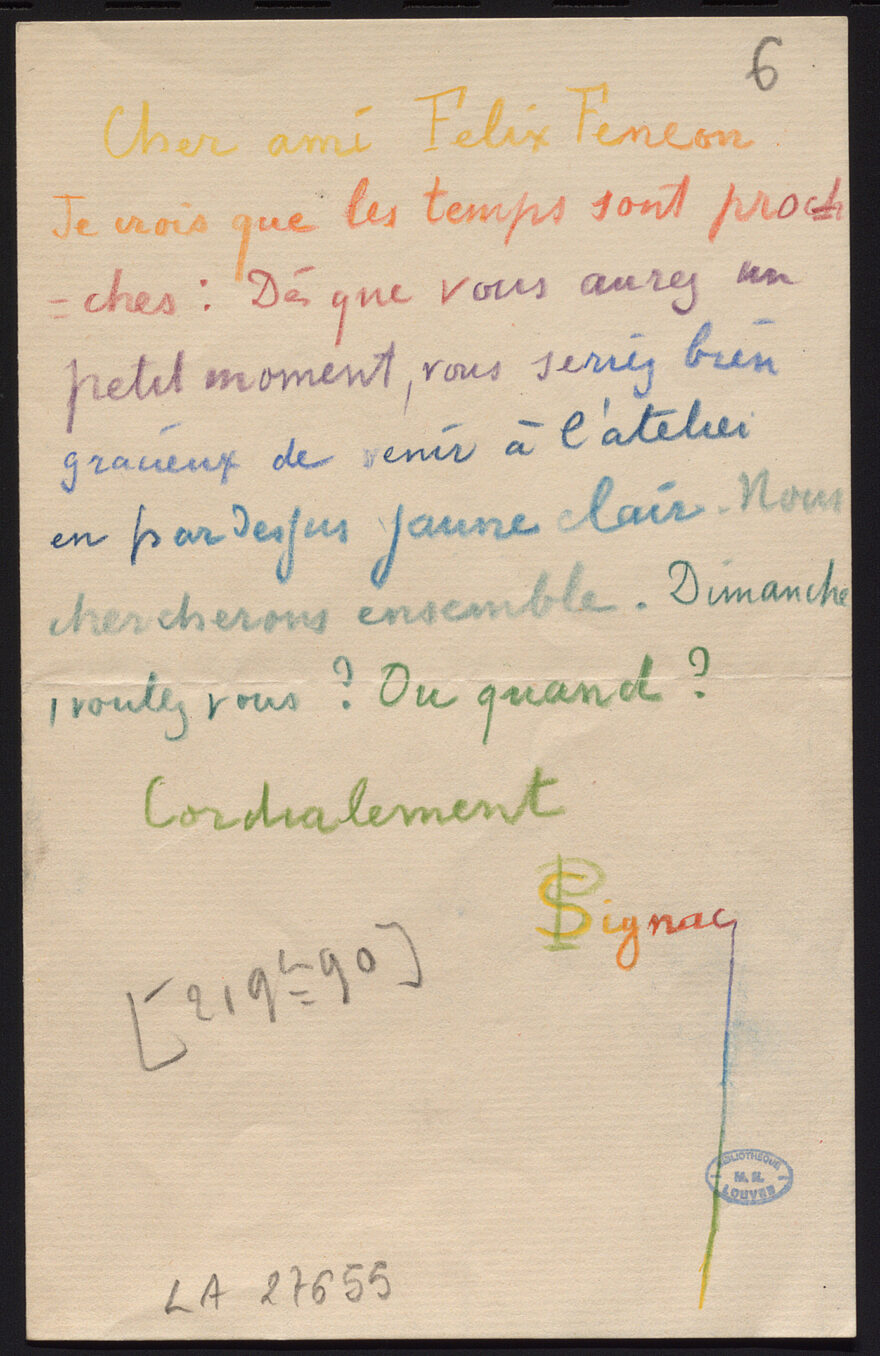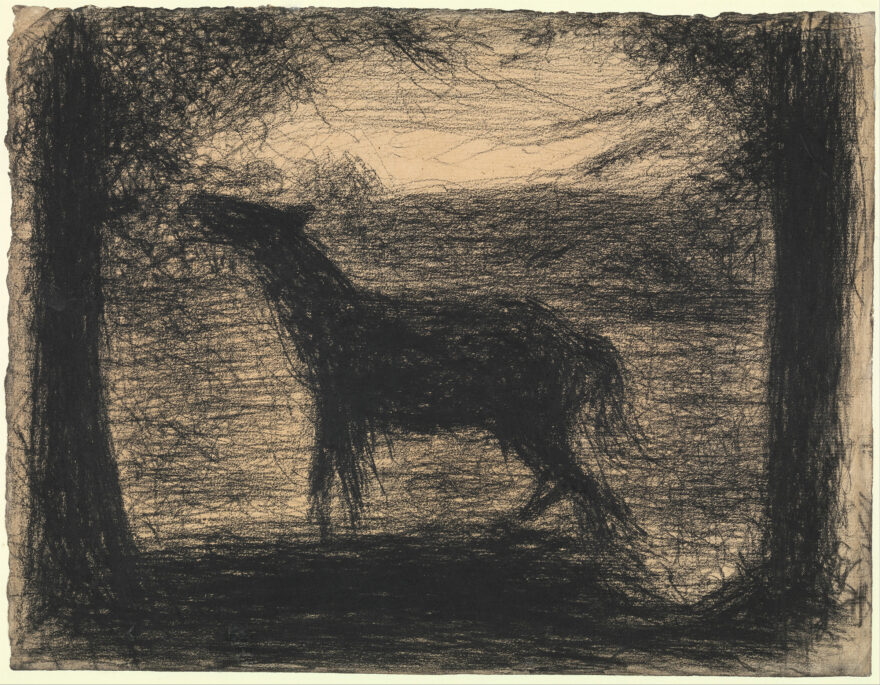Like many exhibits in New York City that were supposed to take place this month, MOMA’s examination of anarchist, art collector, and probable-terrorist Félix Fénéon (1861-1944) has been placed on permanent hold. Instead of perusing an expansive collection of turn-of-the-century artworks and wondering what kind of man Fénéon must have been, we are experiencing grief on a global scale while watching the death toll rise and sheltering in place. Such considerations have somewhat lost their allure. However, it is this sense of collective unease and ambiguity that makes an art-critic-slash-radical with a face straight out of Faust more intriguing than ever. Whatever your thoughts on art and anarchy, a figure like Fénéon’s can only emerge out of rubble and dust.
The context of Fénéon’s life and upbringing was undoubtedly chaotic. Many Parisian artists of his generation, lived in the ruins of the Paris Commune, an idealistic response to the collapse of the French government in 1870. The violent end of the Commune, known as Bloody Week, saw about 15,000 workers, radicals, communists, and, occasionally, children gunned down by the military in the streets of Montmarte. “That Terrible Year [1870-71] mutilated not only the map of our dear country, gutted not only the monuments of our dear city, but deposited something of that destruction in us,” writes the novelist Paul Bourget in his book Nouveaux Essais de Psychologie Contemporaine.
Félix Fénéon lived in a Paris still recovering from these events — still piecing itself together — a Paris on the brink of modernity. Like many creatives who lacked the luxury of family money and its simplifying powers, Fénéon had to balance art and commerce in ways that made him a bit of a paradox. On the one hand, an advocate for violent revolution and experimental art. On the other, a well-mannered (and regularly-paid) clerk for France’s Ministry of War. Yet, he exerted a quiet influence over the art world, lifting up talent wherever he saw it: Fénéon was an early advocate of Rimbaud and Joyce; He wrote with synesthetic prose (“Degas: a thigh, a flower, a chignon… a boozer’s nose, the hand of a milliner amidst a fluttering of feathers and ribbons.”); And it was in anarchist publications such as La Revue Independante, La Vogue, and La Revue Blanche that Fénéon valorized the movement we know today as “Neo-Impressionism,” a term he himself coined. Signac, Seurat, and Matisse were among a few to achieve fame thanks in part to the writing of this austere, towering art critic.
“In 1894, a tall, well-dressed man was observed walking stiffly behind Foyot restaurant… Moments later, an explosion shook the streets.”
The centerpiece of MOMA’s exhibition, which almost no one will see in-person, is a painting of the critic-slash-collector by Signac. Fénéon — who was a bit vain — hated this particular portrait because it was painted in profile, accentuating his prominent nose. Here, Signac casts the critic against a swirl of color inspired by Japanese printmaking. In his political writing, Fénéon outlines a society that mimics natural systems with new, organic connections and creative synapses. Signac’s portrayal seems to capture that ethos with a kind of cosmic undoing — not only with composition but also with his technique of breaking down color to its constituent parts. In the portrait, Fénéon thrusts his arm outward extending a flower to some recipient out of frame, and it’s hard to say whether this painting depicts the end of the world or the beginning. Only four years after Fénéon sits for this particular work, the painting and the flower take on new, violent undertones.

In 1894, following a symphony of anarchist attacks throughout Europe, a tall, well-dressed man was observed walking stiffly behind Foyot restaurant near the Luxembourg Palace. He was holding a potted hyacinth. Moments later, an explosion shook the streets. One of the diners, Laurent Tailhade, a poet and anarchist himself, lost his sight, blinded by flying shards of glass.
Police quickly identified Fénéon, then 32, as a likely culprit thanks in part to his close friendship with another bomber, Émile Henry. (Only a few months earlier, Henry disguised himself in a dress owned by Fénéon’s mother and carried out yet another bombing.). According to reports, the hyacinth he had carried into the alleyway had concealed a rudimentary bomb and fuse. After a search of Fénéon’s home, which yielded no results, the police uncovered 10 detonators at his office at the Ministry of War. He was called to trial along with 30 other anarchists, minor thieves, and dissidents and quickly gained the disdain of the judge. From the court’s transcript:
Judge: ‘It is documented that you were intimate with the German terrorist Kampfmeyer.’
Fénéon: ‘The intimacy cannot have been great as I do not speak German and he does not speak French.’
Judge: ‘But it has been established that you surrounded yourself with Cohen and Ortoz.’
Fénéon: ‘One cannot be surrounded by two persons; you need at least three.’
Judge: ‘You were seen conferring with them behind a lamppost!’
Fénéon: ‘Can you tell me where behind a lamppost is?’
Judge: ‘What do you mean?’
Fénéon: ‘A lamppost, your Honor, is round.’
Fénéon alternated between cutting remarks and playing dumb. “I certainly would not have kept these objects [the detonators] had I been aware of their exact nature.” Despite his obdurate behavior in court — or, perhaps, because of its entertainment value — Fénéon was narrowly released by the jury due to “lack” of evidence but summarily fired from his role in government. Afterward, he quickly took a job as a writer at the daily newspaper La Matin where he continued to push his agenda writing anonymous headlines. These were mini-dramas, scorching depictions of life in Paris, its inequalities, and its injustices. (“The corpse of the sixtyish Dorlay hung from a tree in Arcueil, with a sign reading, ‘Too old to work.’“). Notably, there are very few anarchist bombings in Fénéon’s collected verses, but there are many suicides by debtors. When taken together, the works very nearly serve as an encyclopedia of modern horrors.

Between 1880 and the early 1930s, Fénéon continued to collect an extraordinary number of works from artists of all walks, which he stored in his modest Parisian apartment. The collection, now partially on display at MOMA — though no one is there to see it — includes pieces by Bonnard, Matisse, Signac, Seurat, as well as many artworks from Africa, America, and Oceania. Many of the pieces either depict the suffering of the working class under Capitalism or provide fodder for revolution. Félix Vallotton’s woodcut print La Charge casts policemen as villains. Paul Signac’s Le Démolisseur (The Demolition Worker) closely mimics his sentiment that artists must deliver the “forceful blow of a pickaxe to the antiquated social structure.” Seurat’s atmospheric sketches depict tangled isolated figures that materialize out of smokestacks. But there are also many works that have little to do with politics — except in the broadest of senses where all art is political. Seurat’s three nude studies, rendered in shifting tones of blue and pale pink, are serene in composition and color. They were among Fénéon’s favorites. The collector even crafted little, velvet slips for each one so he never had to leave them at home when he traveled. Matisse’s Interior with a Young Girl (Girl Reading), modeled after his daughter Marguerite, depicts a similarly domestic scene with swaths of cerulean and teal. Another piece, a Congolese totem-turned-sculpture riddled with bits of metal, was once used for healing rituals.
Left: Georges-Pierre Seurat. Haystacks. C. 1882-83. Conté crayon on paper, 9 1/2 x 12 3/4 in. (24.1 x 32.4 cm). Private collection. Photo by Kevin Noble. Right: Georges-Pierre Seurat. Foal. c. 1882-83. Conté crayon on paper, 9 3/4 x 12 1/2 in. (24.8 x 31.8 cm). The Metropolitan Museum of Art, New York. Robert Lehman Collection, 1975.
Much like his minimalist verses for La Matin, which convey meaning largely through what is unsaid, and the darkened, minimalist quality of Seurat’s sketches, Fénéon’s collection and story gesture to a much larger truth than the burgeoning of an art movement or the rise of any individual artist. Just a week before he lost his sight at Foyat, the poet Tailhade posed a question that serves as a strangely adept, if not provocative, distillation of Fénéon’s life and leanings: “Of what vague importance are a few people if the gesture is beautiful?” Fénéon’s story traces a period of radical transformation in several movements. At each stage, we see the burgeoning of mass media, the acceleration of technological growth, social upheaval, infighting, and the harbingers of demons to come. We also see anarchy as creative engine, an agent of a revolution that is both intellectual and political — a revolution that must occur, even at the expense of the very individual that anarchy champions. The explosion is an inherently oppressive text. It is a text that must be read, an imperative statement that crushes human lives while purporting to save them in the same blast. Fénéon must have eventually recognized the irony. Either that, or he became so cynical that he set aside the idea of a revolution. The Foyot attack seems to be his first and last bombing before turning his attention fully to the arts — and the subtle subversion of transforming bourgeois tastes from within.
As Fénéon wrote toward the end of his life, “I aspire only to silence.”
MOMA’s exhibit of Félix Fénéon The Anarchist and the Avant-Garde— From Signac to Matisse and Beyond is on view through July 25, 2020 and available via virtual viewing. For more information please visit MOMA’s virtual viewing schedule here. Thank you to the museum for collaborating with us and providing imagery for this piece.


